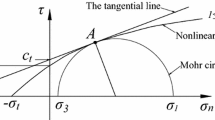Abstract
Determination of distribution and magnitude of active earth pressure is crucial in retaining wall designs. A number of analytical theories on active earth pressure were presented. Yet, there are limited studies on comparison between the theories. In this work, comparison between the theories with finite element analysis is done using the PLAXIS software. The comparative results show that in terms of distribution and magnitude of active earth pressure, RANKINE’s theory possesses the highest match to the PLAXIS analysis. Parametric studies were also done to study the responses of active earth pressure distribution to varying parameters. Increasing soil friction angle and wall friction causes decrease in active earth pressure. In contrast, active earth pressure increases with increasing soil unit weight and height of wall. RANKINE’s theory has the highest compatibility to finite element analysis among all theories, and utilization of this theory leads to proficient retaining wall design.
Similar content being viewed by others
References
DAS B M. Principles of foundation engineering [M]. 7th ed. Singapore: International Thomson Publishing Asia, 2010.
BOWLES J E. Foundation analysis and design [M]. 5th ed. Singapore, McGraw-Hill, 1996.
TERZAGHI K. A fundamental fallacy in earth pressure computations [J]. Journal of Boston Society of Civil Engineers, 1936, 23: 71–88.
ROSCOE K H. The influence of strains in soil mechanics [J]. Geotechnique, 1970, 20(2): 129–170.
DUBROVA G A. Intersection of soil and structures [M]. Moscow, Izd. Rechnoy Transport, 1963.
WANG Y Z. Distribution of earth pressure on a retaining wall [J]. Geotechnique, 2000, 50(1): 83–88.
PAIK K H, SALGADO R. Estimation of active earth pressure against rigid retaining walls considering arching effects [J]. Geotechnique, 2003, 53(7): 643–653.
GOEL S, PATRA N R. Effect of arching on active earth pressure for rigid retaining walls considering translation mode [J]. International Journal of Geomechanics, 2008, 8(2): 123–133.
TERZAGHI K. Theoretical soil mechanics [M]. New York: John Wiley and Sons, 1954.
HAZARIKA H, MATSUZAWA H. Wall displacement modes dependant active earth pressure analyses using shear band method with two bands [J]. Computer and Geotechnics, 1996, 19(3): 193–219.
SOKOLOVSKI V V. Statics of soil media [M]. 2nd ed. London: Butterworths Scientific Publications, 1960.
YANG Kuo-hsin, LIU Chia-nan. Finite element analysis of earth pressures for narrow retaining walls [J]. Journal of GeoEngineering, 2007, 2(2): 43–52.
FRYDMAN S, KEISSAR I. Earth pressure on retaining walls near rock faces [J]. Journal of Geotechnical Engineering: ASCE, 1987, 113(6): 586–599.
TAKE W A, VALSANGKAR A J. Earth pressure on unyielding retaining walls of narrow backfill width [J]. Canadian Geotechnical Journal, 2001, 38: 1220–1230.
SALMAN F A, AL-SHKARCHI Y J, HUSAIN H M, SABRE D K. Distribution of earth pressure behind retaining walls considering different approaches [J]. International Journal of the Physical Sciences, 2010, 5(9): 1389–1400.
LIN Yu-lian, LIU Yong-jian, LI Jia-le. Dynamic response law about gravity retaining wall to seismic characteristics and earth fill properties [J]. Journal of Central South University, 2012, 19(3): 657–663.
YANG Xiao-li. Upper bound limit analysis of active earth pressure with different fracture surface and nonlinear yield criterion [J]. Theoretical and Applied Fracture Mechanics, 2007, 47: 46–56.
EVANGELISTA A, SANTOLO A S D, SIMONELLI A L. Evaluation of pseudostatic active earth pressure coefficient of cantilever retaining walls [J]. Soil Dynamics and Earthquake Engineering, 2010, 30: 1119–1128.
ZHU Jian-feng, XU Ri-qing, LI Xin-rui, CHEN Ye-kai. Calculation of earth pressure based on disturbed state concept theory [J]. Journal of Central South University of Technology, 2011, 18(4): 1240–1247.
Author information
Authors and Affiliations
Corresponding author
Additional information
Foundation item: Project(RG086/10AET) supported by the Institute of Research Management and Monitoring, University of Malaya, Malaysia
Rights and permissions
About this article
Cite this article
Yap, S.P., Salman, F.A. & Shirazi, S.M. Comparative study of different theories on active earth pressure. J. Cent. South Univ. 19, 2933–2939 (2012). https://doi.org/10.1007/s11771-012-1361-2
Received:
Accepted:
Published:
Issue Date:
DOI: https://doi.org/10.1007/s11771-012-1361-2



